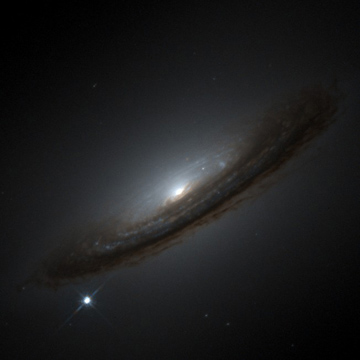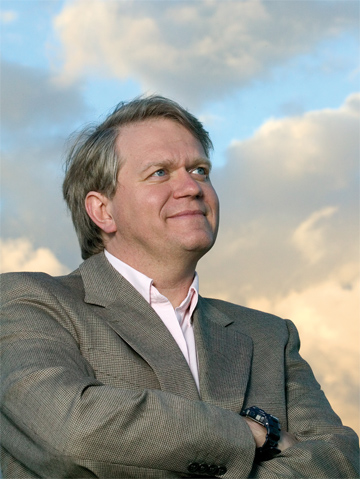17th Kaczmarczik Lecture
"The Accelerating Universe"
Brian Schmidt, PhD
Winner of the 2011 Nobel Prize in Physics
Thursday, March 1, 2012
3:00 p.m.
Main Building Auditorium
3141 Chestnut Street
Philadelphia, PA 19104
 In 1998 two teams traced back the expansion of the universe over billions of years and discovered that it was accelerating, a startling discovery that suggests that more than 70% of the cosmos is contained in a previously unknown form of matter, called Dark Energy. The 2011 Nobel Laureate for Physics, Brian Schmidt, leader of the High-Redshift Supernova Search Team, will describe this discovery and explain how astronomers have used observations to trace our universe's history back more than 13 billion years, leading them to ponder the ultimate fate of the cosmos.
In 1998 two teams traced back the expansion of the universe over billions of years and discovered that it was accelerating, a startling discovery that suggests that more than 70% of the cosmos is contained in a previously unknown form of matter, called Dark Energy. The 2011 Nobel Laureate for Physics, Brian Schmidt, leader of the High-Redshift Supernova Search Team, will describe this discovery and explain how astronomers have used observations to trace our universe's history back more than 13 billion years, leading them to ponder the ultimate fate of the cosmos.
 Brian Schmidt is a Laureate Fellow at The Australian National University's Mount Stromlo Observatory. Brian was raised in Montana and Alaska, USA, and received undergraduate degrees in Physics and Astronomy from the University of Arizona in 1989. Under the supervision of Robert Kirshner, he completed his Astronomy Master's degree (1992) and PhD (1993) from Harvard University. In 1994 he and Nick Suntzeff formed the HighZ SN Search team, a group of 20 astronomers on 5 continents who used distant exploding stars to trace the expansion of the Universe back in time. This group's discovery of an accelerating Universe was named Science Magazine's Breakthrough of the Year for 1998. Brian Schmidt joined the staff of the Australian National University in 1995, and was awarded the Australian Government's inaugural Malcolm McIntosh award for achievement in the Physical Sciences in 2000, The Australian Academy of Sciences Pawsey Medal in 2001, the Astronomical Society of India's Vainu Bappu Medal in 2002, and an Australian Research Council Federation Fellowship in 2005. In 2006 Schmidt was jointly awarded the US$1M Shaw Prize for Astronomy, and shared the US$0.5M 2007 Gruber Prize for Cosmology with his High-Z SN Search Team colleagues. In 2008 he was elected a Fellow of the Australian Academy of Sciences, a Fellow of the United States National Academy, and Foreign Member of the Spanish Royal Academy of Sciences. His work on the accelerating universe was awarded the 2011 Nobel Prize in Physics, jointly with Adam Riess and Saul Perlmutter. Brian is continuing his work using exploding stars to study the Universe, and is leading Mt Stromlo’s effort to build the SkyMapper telescope, a new facility that will provide a comprehensive digital map of the southern sky from ultraviolet through near infrared wavelengths.
Brian Schmidt is a Laureate Fellow at The Australian National University's Mount Stromlo Observatory. Brian was raised in Montana and Alaska, USA, and received undergraduate degrees in Physics and Astronomy from the University of Arizona in 1989. Under the supervision of Robert Kirshner, he completed his Astronomy Master's degree (1992) and PhD (1993) from Harvard University. In 1994 he and Nick Suntzeff formed the HighZ SN Search team, a group of 20 astronomers on 5 continents who used distant exploding stars to trace the expansion of the Universe back in time. This group's discovery of an accelerating Universe was named Science Magazine's Breakthrough of the Year for 1998. Brian Schmidt joined the staff of the Australian National University in 1995, and was awarded the Australian Government's inaugural Malcolm McIntosh award for achievement in the Physical Sciences in 2000, The Australian Academy of Sciences Pawsey Medal in 2001, the Astronomical Society of India's Vainu Bappu Medal in 2002, and an Australian Research Council Federation Fellowship in 2005. In 2006 Schmidt was jointly awarded the US$1M Shaw Prize for Astronomy, and shared the US$0.5M 2007 Gruber Prize for Cosmology with his High-Z SN Search Team colleagues. In 2008 he was elected a Fellow of the Australian Academy of Sciences, a Fellow of the United States National Academy, and Foreign Member of the Spanish Royal Academy of Sciences. His work on the accelerating universe was awarded the 2011 Nobel Prize in Physics, jointly with Adam Riess and Saul Perlmutter. Brian is continuing his work using exploding stars to study the Universe, and is leading Mt Stromlo’s effort to build the SkyMapper telescope, a new facility that will provide a comprehensive digital map of the southern sky from ultraviolet through near infrared wavelengths.
High School Open House Program:
12:00-12:30 p.m. Main Building Auditorium
12:30-2:30 p.m. Department of Physics Open House
Brief presentations on Biophysics, Astrophysics, Computational Physics, Condensed Matter, Nonlinear Dynamics, Particle Physics, etc. An excellent opportunity for high school students to visit our laboratories and meet in person with our internationally recognized researchers.
2:30-3:00 p.m. Reception
About the Kaczmarczik Lecture
Paul Kaczmarczik began his career as a Professor of Physics at Drexel University in 1953. A key player in building the Physics and Atmospheric Science Department, he made important contributions to teaching at Drexel University during his many years of service. Well-liked by both his colleagues and his students, Professor Kaczmarczik became Professor Emeritus in 1989. The Kaczmarczik Lecture Series was established in 1995 in honor of Professor Kaczmarczik. It brings to Drexel outstanding scientists to present lectures on topics at the cutting edge of Physics research.